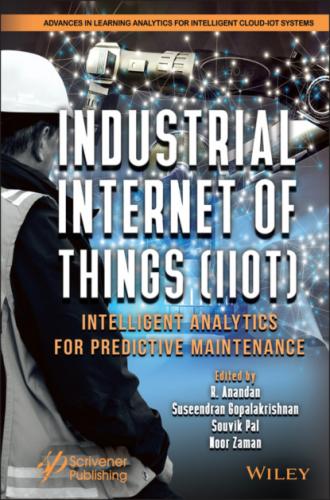Guide
1 Cover
5 Preface
7 Index
List of Illustrations
1 Chapter 1Figure 1.1 Big data analytics illustration.Figure 1.2 Big data illustration.Figure 1.3 AI and data science illustration.Figure 1.4 Internet of Things.Figure 1.5 IoT illustration.Figure 1.6 Connection to the car’s illustration.Figure 1.7 IoT devices.Figure 1.8 IoT and blockchain illustration.Figure 1.9 Maintenance IoT vehicle illustration.
2 Chapter 3Figure 3.1 Connections and linked objects of IoT.Figure 3.2 Autonomous robots with Industry 4.0.Figure 3.3 Architecture of SCADA.Figure 3.4 Smart grid conceptual model.Figure 3.5 Smart grid security.Figure 3.6 Classification of IoT-aided smart grid.Figure 3.7 Advanced metering infrastructure.
3 Chapter 4Figure 4.1 Working of IIoT.Figure 4.2 Big data analytics with IoT.Figure 4.3 Types of ML.Figure 4.4 Supervised and unsupervised learning.Figure 4.5 Reinforcement learning.Figure 4.6 Disaster lifecycle.
4 Chapter 5Figure 5.1 Construction of biological neuron.Figure 5.2 McCulloch-Pitts model.Figure 5.3 Multi-layer perceptron structure.Figure 5.4 A two-layered network.Figure 5.5 A recurrent network.Figure 5.6 AND network.Figure 5.7 OR network.Figure 5.8 XOR network.
5 Chapter 6Figure 6.1 Schematic of single patch on textile substrate [34].Figure 6.2 Side view of the five-layer model [34].Figure 6.3 The antenna geometry with MTM cells [36].Figure 6.4 Antenna design with partial ground: (a) front view; (b) back view.Figure 6.5 Logo-based tracking system [38].Figure 6.6 Antenna with EBG structure [41].Figure 6.7 Reconfigurable Antenna of O-shape: (a) OFF; (b) ON [43].Figure 6.8 UHF RFID tag antenna design [45].Figure 6.9 UHF RFID tag read range measurements vs. frequency [45].Figure 6.10 Gain, efficiency vs. frequency for Zelt antenna [46].Figure 6.11 Wearable fractal antenna with different iterations: (a) 0th; (b) 1st...Figure 6.12 Wearable fractal antenna with iterations: (a) 0th; (b) 1st; and (c) ...Figure 6.13 The embroidered Sierpinski carpet antenna: (a) substrate material; (...
6 Chapter 7Figure 7.1 IoT protocol with OSI standard.Figure 7.2 IoT layers and protocols.Figure 7.3 IoT packet headers.Figure 7.4 Confirmable message passing mechanism.Figure 7.5 Non-confirmable message passing mechanism.Figure 7.6 MQTT subscriber-publisher model.Figure 7.7 IoT components.Figure 7.8 IoT communication architecture.Figure 7.9 Data center architecture.Figure 7.10 Fog computing.Figure 7.11 Edge computing.Figure 7.12 Stages of machine learning.Figure 7.13 Classification of machine learning that can be supported in IoT.Figure 7.14 Challenges in IoT and data center.
7 Chapter 8Figure 8.1 Multidrone architecture for autonomous cinematography.Figure 8.2 Current technologies in aviation industry.
8 Chapter 9Figure 9.1 Water quality factors.Figure 9.2 Water quality management framework.Figure 9.3 Intelligent IoT-based water quality management framework.Figure 9.4 Smart wastewater quality monitoring system.Figure 9.5 Containments of sensing in water.
9 Chapter 10Figure 10.1 Aircraft monitoring system.Figure 10.2 IoT information chain to collect aviation data.Figure 10.3 High-end engine in jet plane.Figure 10.4 Fuel emissions from jet airplane.Figure 10.5 IoT real-time connectivity in airline industries.Figure 10.6 Smart luggage IoT connected tracking system.Figure 10.7 Evaluation and performance improvement.Figure 10.8 Steps involved in fuel consumption.Figure 10.9 Optimization of aircraft fuel.Figure 10.10 Overall idea for fuel cost optimization.Figure 10.11 High-end platform in travel route comparison for optimization.
10 Chapter 11Figure 11.1 Flow diagram of the proposed system.Figure 11.2 Architecture of the proposed system.Figure 11.3 YOLO architecture.Figure 11.4 Pages in the Android app.Figure 11.5 Experimental setup of the proposed system.Figure 11.6 (a) Annotating images in VoTT (b) Annotating images in VoTT.Figure 11.7 Object detection using YOLO model trained with 100 (a) vs. 200 (b) v...Figure 11.8 Object detection using YOLO model trained with 100 (a) vs. 200 (b) v...Figure 11.9 Graph of epoch vs. loss during training.Figure 11.10 Output from NodeMCU in serial monitor.
11 Chapter 12Figure 12.1 Knowledge discovery in databases.Figure 12.2 Data mining in Pharmacovigilance.Figure 12.3 Semi-Convergent Matrix construction for improving search accuracy.Figure 12.4 Structure of neural predictive classifier for classification.Figure 12.5 Processing diagram of activation function for classification.Figure 12.6 Neural predictive classifier.
12 Chapter 13Figure 13.1 IIoT infrastructure.Figure 13.2 Applications of IIoT.Figure 13.3 Impact of COVID-19 on the connected applications software market.Figure 13.4 Examples of “winners” in industrial IoT solutions.Figure 13.5 Impact of COVID-19 on IoT.Figure 13.6 Download rank.Figure 13.7 Usage of Librestram’s Onsight.Figure 13.8 Download Rank of the app “Kinsa Health”.Figure 13.9 Impact of COVID-19 on technology.Figure 13.10 Zoom usage analysis.
13 Chapter 14Figure 14.1 Use-case diagram.Figure 14.2 Welcome page.Figure 14.3 Signup page.Figure 14.4 Home page.Figure 14.5 Ambulance section.Figure 14.6 Ambulance selection page.Figure 14.7 Confirmation of booking.Figure 14.8 Ambulance booking app.Figure 14.9 Booking system.
14 Chapter 15Figure 15.1 Schematic representation of the suggested methodology.Figure 15.2 Hardware prototype.Figure 15.3 Health data vs. specificity.Figure 15.4 Health data vs. sensitivity.Figure 15.5 Health data vs. false out.Figure 15.6 Health data vs. positive predictive value.Figure 15.7 Health data vs. false discovery rate.Figure 15.8 Health data vs. miss rate.Figure 15.9 Health data vs. F-score.Figure 15.10 Health data vs. accuracy.Figure 15.11 Time taken for encryption.Figure 15.12 Time taken for decryption.
List of Tables
1 Chapter 4Table 4.1 Types of assets needs safety [50].
2 Chapter 6Table 6.1 Chronology for the wearable antennas.Table 6.2 SAR values of the antenna with varying distance [35].Table 6.3 Max average SAR values at different distances from human body [36].Table 6.4 Impedance characteristics of proposed denim antenna [37].Table 6.5 Different textile materials with their dielectric constant values.Table 6.6 Description of textile materials.Table 6.7 Comparison of wearable antenna designs.
3 Chapter 7Table 7.1 IoT protocols.Table 7.2 Comparison of CoAP and MQTT.Table 7.3
